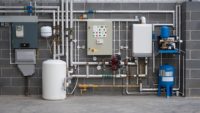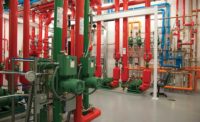The race is on.
That’s how Grundfos USA President and General Manager Jonathan Hamp-Adams sees one key trend when it comes to pumps.
“Overwhelmingly, there is a race by all the industry leaders to connect equipment and collect data,” he explains. “Some are calling it intelligent water, connectivity or smart solutions.”
Hamp-Adams says, ultimately, everybody is trying to find the same holy grail.
“What to do with all this data and how to commercialize or monetize it,” he says. “Right now, we are seeing a lot of apps and on-the-fly mobile data used in some form of dashboard. It’s easy to make a dashboard that looks great, but providing truly relevant data and turning that into value creating actionable insights is something yet to be fully identified and done.”
Along those connected lines, manufacturers see the industry morphing toward using connectivity to prevent problems before they occur.
“Continued advancement in smart technology,” says Liberty Pumps Vice President of Sales & Marketing Randy Waldron when asked what the next big thing in the pumps vertical will be. “This would includes things such as monitoring of pump equipment and performance. The ability to determine when service or maintenance is required before pump failure occurs. This technology has made its way into commercial and municipal pump applications, but has a long way to go in regard to its use on smaller residential pump equipment.”
Hamp-Adams says the future revolves around dynamic optimization and true intelligence.
“This will appear in multiple ways,” he says. “The first is making service invisible. You won’t need to think about it anymore. It will just happen, and it is going to make people’s lives easier. Let’s say your pump needs a new seal. Before you know it, the pump has ordered the part and scheduled an appointment with the technician without human intervention.
“Secondly, integrated pumps, other equipment and management systems will intelligently influence the building’s use for optimum efficiency,” he continues. “If you have a 20-story hotel with 50% occupancy, your systems will only book guests on the first 10 floors and booster pumps will use less energy because they don’t need to pump water higher than necessary. Pumps, intelligently working in conjunction with the full mechanical and plumbing system, will play a greater role in water conservation and energy optimization.”
Federal efficiencies
Numerous manufacturers brought up the governmental piece when it comes to future trends with pumps.
“I think we are seeing some of the same issues in pumps that we are seeing in other areas of the industry,” says Alan Jones, global product manager for Bell & Gossett centrifugal pumps. “The number of pump options and features in the marketplace is growing, which makes it even harder to make selections. There is some great work being done by the Department of Energy to drive continued improvement in pump and electric motor efficiency, but misapplication of pumps — no matter how efficient they are — will continue to create system issues and waste energy. The vast number of options combined with productivity pressures, and the fact many professionals in the field have retired, create a very challenging environment for young engineers and contractors.”
Hamp-Adams is seeing demand from both users and the government for more efficient solutions.
“This is going to happen well into the future,” he says. “But when we think about efficiency for pumps, it is not just energy consumption. At Grundfos, we are driven to help solve the world’s current and future water and energy challenges. There are countries using pumps powered by traditional motors, and countries using more sustainable and inexhaustible technologies such as solar energy. Globally, there is too much water in places where we don’t want it and not enough where there is a critical need. To create the necessary balance for sustainability, this challenge will need to be solved using the least amount of traditional energy source as possible.”
Steven Lane, communications manager at Armstrong Fluid Technology, says design engineers, contractors, facility managers and owners should be aware of the new DOE regulations.
“More to the point, they should be aware of the limitations of those regulations,” he says, “and the fact that the energy efficiency requirements represent a reasonably good starting point. To achieve what is genuinely the best efficiency for a pump and an HVAC system, it is important to understand the entire performance profile, and the efficiencies across the range in which the pump will be required to function.”
More trends
Waldron notes grinder pumps continue to grow in popularity in the commercial space.
“With the continued design advancements coming from many different pump manufacturers, grinders continue to provide a better solution for handling difficult solids and reducing required maintenance from pump jamming,” he says.
Jones sees a less is more approach in his pumps crystal ball.
“We are definitely seeing the impact of the continued push for productivity and operating cost reduction,” he says. “This manifests itself in a few ways. For example, at the selection and design phase, the cycle times are shorter and the available resources fewer. This has placed more responsibility on the manufacturer to recommend solutions and provide detailed performance data and product information.
“We have been continually enhancing our selection software and product submittals to meet these needs,” he continues. “The same holds true for pump installation and ongoing maintenance. Systems must be easy to commission and operate trouble-free. Longer uptime expectations and fewer maintenance staff calls for simple, less frequent required maintenance. This makes it even more important to have the right selections during the design phase. It also means systems need built-in monitoring and advance warning systems to address problems before they mount.”
Lane notes sophistication in products in this space will continue to soar.
“At the pump level, we definitely expect to see further development in the sophistication of pump intelligence and communication capabilities,” he says. “At the larger system level, we expect pumps will be affected by the development of more advanced technologies for artificial intelligence and self-learning within mechanical systems. The energy savings potential of this self-learning capability will likely further drive demand for built-in intelligence at the device level.”






